The Long-eared Owl (Asio otus) emerges as a captivating nocturnal raptor, characterized by its distinct appearance and remarkable adaptability.
With a wingspan of 35-39 inches, this medium-sized owl is renowned for its ear tufts, which, despite the name, are not actual ears.
Found across diverse habitats in Europe, Asia, North America, and Africa, the Long-eared Owl showcases a mottled plumage that provides exceptional camouflage in wooded environments.
Preferring coniferous forests, woodlands, and open fields, these owls are expert nocturnal hunters with keen vision and silent flight.
Their territorial behaviors, communal roosting during winter, and dedicated parental care add layers to their intriguing social dynamics.
As a sentinel of healthy ecosystems, the Long-eared Owl’s adaptability and distinctive features make it a fascinating subject for bird enthusiasts and a crucial player in maintaining ecological balance. So, stay focused.
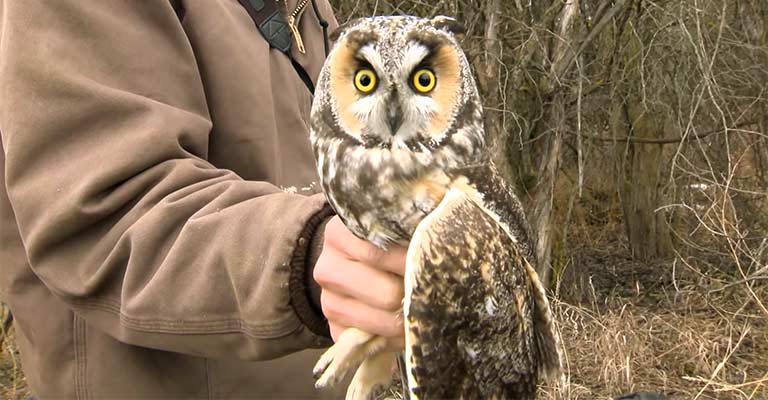
Identifying Characteristics of Long-eared Owl
The Long-eared Owl (Asio otus) is a fascinating nocturnal bird known for its distinct appearance and behavior.
Identifying these owls can be a rewarding experience for bird enthusiasts, but it requires a keen eye and understanding of their unique characteristics.
Here are some of the key points to help you identify the Long-eared Owl:
Ear Tufts
One of the most distinctive features of the Long-eared Owl is its prominent ear tufts, which are feathered tufts on the top of its head.
Despite their name, these tufts are not actual ears; the owl’s ears are located on the sides of its head. The tufts serve as a form of camouflage and are raised or lowered based on the bird’s mood.
Facial Disk
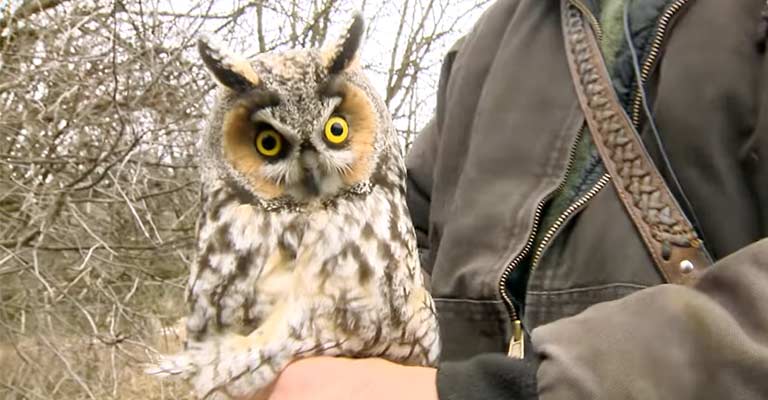
Long-eared Owls, like many owl species, have a facial disk, a circular arrangement of feathers around their eyes.
The disk helps funnel sound to their ears, aiding in their exceptional hearing abilities. The facial disk is often lighter in color than the rest of the plumage.
Plumage
Long-eared Owls have mottled brown and buff-colored plumage that provides excellent camouflage against the bark of trees.
This patterned appearance helps them blend seamlessly into their woodland habitats, making them challenging to spot.
Size and Shape
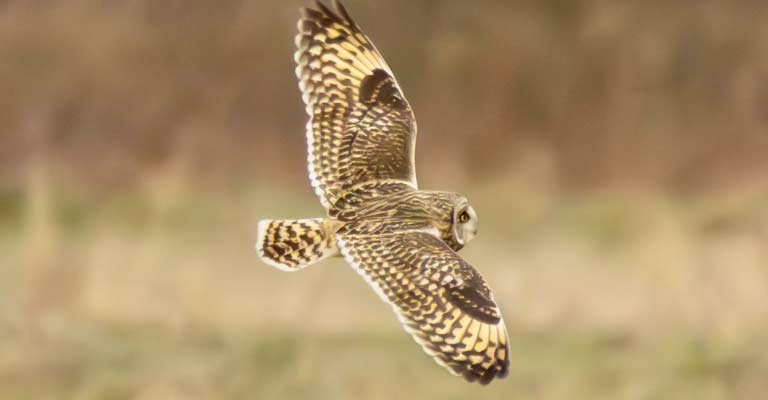
Long-eared Owls are medium-sized owls with a wingspan of around 35-39 inches (89-99 cm).
They have a slender, elongated body and long wings, giving them an agile and stealthy flight. Despite their large wingspan, their overall size can be deceptive due to their fluffy feathers.
Eye Color

The eyes of Long-eared Owls are typically orange or yellow, adding a striking contrast to their facial disk.
Their eyes are forward-facing, providing them with binocular vision essential for hunting in low-light conditions.
Habitat
These owls are often found in dense woodlands and coniferous forests. They prefer habitats with tall trees where they can roost during the day and hunt for small mammals, birds, and insects during the night.
Nocturnal Behavior
Long-eared Owls are primarily nocturnal, meaning they are most active during the night. Observing their nocturnal behavior, such as hunting or perching in trees, can be a key clue in identifying them.
Silent Flight
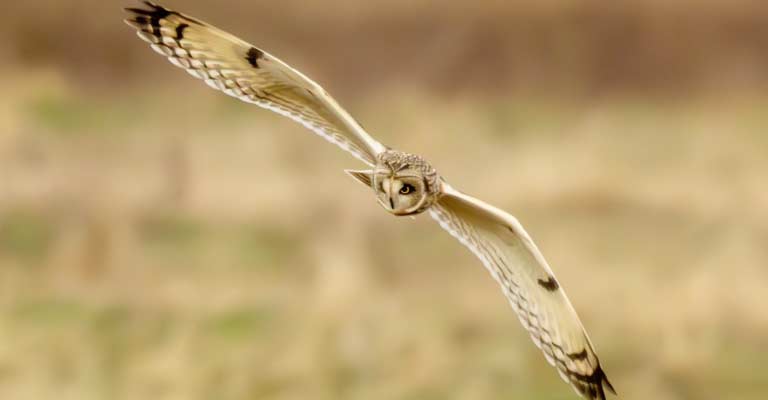
Similar to other owl species, Long-eared Owls possess specialized feathers that help reduce sound when flying. This adaptation allows them to approach prey quietly, making their flight nearly silent.
Identifying the Long-eared Owl involves a combination of physical characteristics, behavioral traits, and habitat preferences.
By paying attention to these eight key points, birdwatchers can enhance their chances of spotting and appreciating these captivating creatures in their natural environment.
Taxonomy of Long-eared Owl
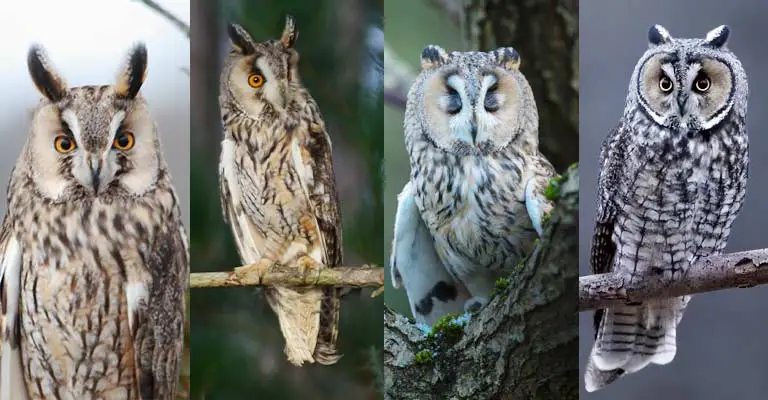
Check out the below table summarizing the taxonomy details of the Long-eared Owl:
| Taxonomic Rank | Classification |
| Domain | Eukaryota |
| Kingdom | Animalia |
| Phylum | Chordata |
| Class | Aves |
| Order | Strigiformes |
| Family | Strigidae |
| Genus | Asio |
| Species | A. otus |
The Long-eared Owl (Asio otus) exhibits a captivating diversity through its recognized subspecies, each adding a unique dimension to the species.
Four distinct subspecies have been identified, contributing to the overall richness of this owl’s population:
- Asio otus otus: This is the nominate subspecies, commonly found in Europe and Asia. It boasts the characteristic features of the Long-eared Owl, including prominent ear tufts, mottled plumage, and keen nocturnal hunting abilities. Its presence in diverse habitats across its range reflects its adaptability.
- Asio otus canariensis: The Canary Islands host the subspecies Asio otus canariensis. These owls have adapted to the unique ecosystems of the archipelago, showcasing variations influenced by insular environments. Their presence highlights the species’ ability to adapt to different geographical and ecological conditions.
- Asio otus tuftsi: Found in North America, Asio otus tuftsi represents the subspecies residing in this continent. The North American Long-eared Owl exhibits characteristics that distinguish it from its counterparts, reflecting the influences of the region’s ecosystems and environmental factors.
- Asio otus wilsonianus: The subspecies Asio otus wilsonianus is prevalent in parts of North America, including Alaska and Canada. These owls showcase adaptations to the colder climates of their range, emphasizing the species’ ability to thrive in a variety of temperature conditions.
Exploring the diverse subspecies of the Long-eared Owl provides a comprehensive view of its adaptability across continents and regions.
Understanding these variations contributes to our broader knowledge of avian ecology and the intricate ways in which these owls have evolved to suit their respective habitats.
Long-eared Owl As A Predator

The Long-eared Owl (Asio otus) stands as an adept and stealthy predator, showcasing a remarkable set of characteristics and behaviors that make it an effective hunter in its chosen habitats.
Here are key aspects that highlight the Long-eared Owl’s prowess as a predator:
Hunting Technique
Long-eared Owls are skilled nocturnal hunters, using the cover of darkness to their advantage. Their keen eyesight and exceptional hearing allow them to locate prey even in low light conditions.
They primarily rely on sit-and-wait hunting, perching in trees or on the ground and patiently scanning their surroundings for any signs of movement.
Dietary Preferences
The primary diet of Long-eared Owls consists of small mammals such as mice, voles, shrews, and occasionally small birds.
Their adaptability allows them to adjust their diet based on the availability of prey in their habitat.
These owls play a crucial role in controlling rodent populations, making them valuable to ecosystems.
Silent Flight
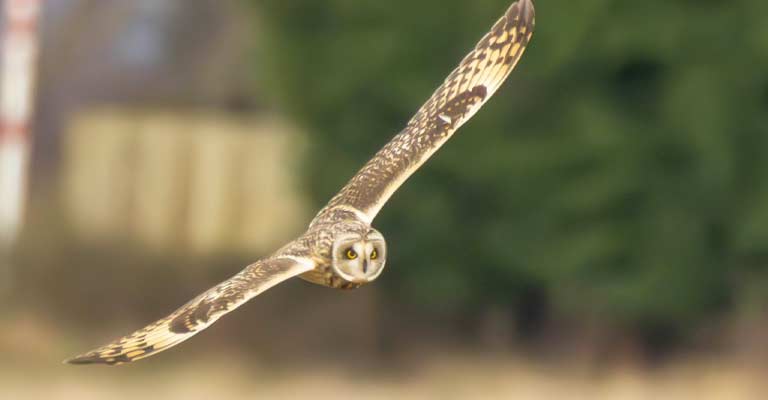
Long-eared Owls possess specialized feathers on their wings that reduce turbulence and noise during flight, making their approach virtually silent.
This adaptation is crucial for ambushing prey, ensuring that their presence remains undetected until the last moment.
Binocular Vision
The forward-facing placement of their eyes provides Long-eared Owls with binocular vision, enhancing their depth perception.
This visual acuity is essential for accurately gauging distances, especially when swooping down to catch prey.
Facial Disk and Hearing
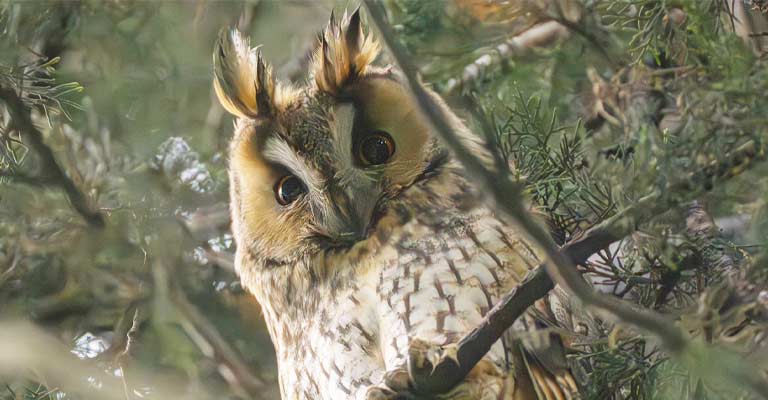
The facial disk, a characteristic feature of many owl species, aids in funneling sound to their ears.
Long-eared Owls have highly sensitive hearing, allowing them to detect the rustling of prey in leaves or snow. This keen auditory sense assists them in locating and capturing prey with precision.
Adaptation to Various Habitats
Long-eared Owls can be found in a range of habitats, including woodlands, grasslands, and open fields.
Their ability to adapt to diverse environments allows them to exploit different types of prey and increases their overall success as predators.
Territorial Behavior
Long-eared Owls are known to establish territories during the breeding season. Defending a specific area ensures a stable and reliable source of prey for themselves and their offspring.
This territorial behavior contributes to maintaining a balance in local ecosystems.
Parental Care
The commitment to successful predation extends to their parenting strategies. Long-eared Owls exhibit dedicated parental care, with both parents participating in hunting and provisioning food for their chicks.
This ensures the healthy development of their offspring and, subsequently, the continuation of their species.
The Long-eared Owl’s role as a predator is finely tuned to its nocturnal lifestyle and habitat preferences.
Its combination of silent flight, acute senses, adaptability, and parenting strategies makes it a formidable and ecologically significant presence in the ecosystems it inhabits.
Long-eared Owl Life History
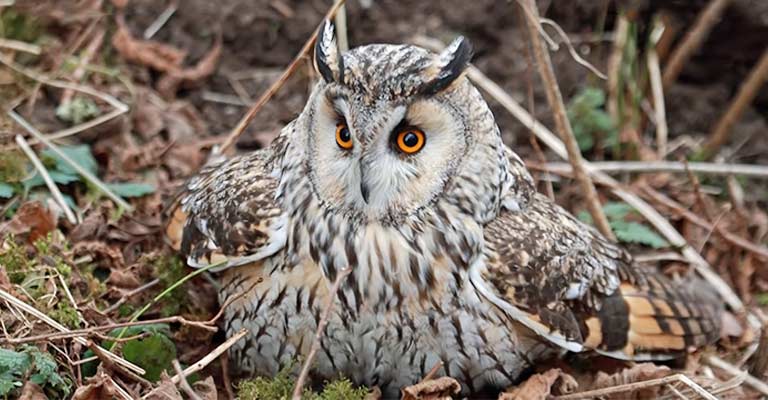
The Long-eared Owl (Asio otus) is a captivating nocturnal bird of prey, distinguished by its ear tufts and remarkable hunting abilities.
Exploring the life history of these owls unveils a fascinating journey encompassing various aspects such as their diet, habitat preferences, breeding behavior, and the challenges they face in the wild.
Food
Long-eared Owls primarily prey on small mammals, favoring rodents like mice, voles, and shrews. Occasionally, they may capture small birds and insects.
Their nocturnal lifestyle and excellent hunting skills, aided by acute vision and sensitive hearing, make them efficient predators.
Long-eared Owls play a crucial role in maintaining ecological balance by controlling rodent populations.
Habitat
These owls exhibit adaptability to a diverse range of habitats, including woodlands, coniferous forests, grasslands, and open fields.
They often select areas with a mix of trees for roosting and nesting, while their choice of hunting grounds depends on the abundance of suitable prey.
Range Map
Long-eared Owls have a wide distribution across North America, Europe, Asia, and parts of northern Africa. Range maps depict their presence in various regions, showcasing the global extent of their habitat.
Nesting
Long-eared Owls are meticulous in selecting nesting sites, often choosing abandoned crow or raptor nests.
The female lays a clutch of eggs, and both parents share the responsibility of incubation. The presence of ear tufts, often lowered during nesting, helps in camouflage and protection.
Breeding
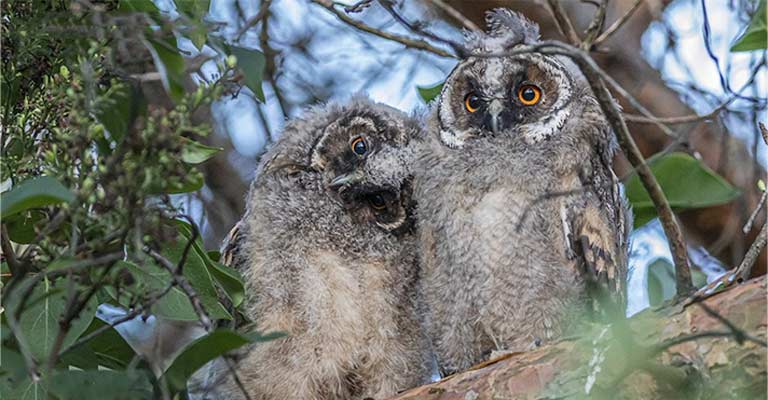
Breeding season typically occurs in the early spring. Long-eared Owls exhibit monogamous behavior, with pairs forming long-term bonds.
After hatching, the parents diligently care for their chicks, providing them with food and protection until they fledge and become independent.
Diseases
Long-eared Owls, like many avian species, can be susceptible to various diseases.
Avian pox, aspergillosis, and external parasites are potential threats. Monitoring their health is crucial for conservation efforts, as diseases can impact population numbers.
Treatment
Veterinary intervention may be required for Long-eared Owls affected by diseases.
Avian specialists conduct examinations, administer treatments, and, when possible, rehabilitate injured or sick birds. Efforts to minimize the impact of diseases contribute to the overall well-being of the population.
Conservation
Conservation initiatives play a vital role in ensuring the continued survival of Long-eared Owls.
Preserving their natural habitats, maintaining a balance in prey populations, and educating the public about the significance of these birds contribute to conservation efforts.
Monitoring and addressing potential threats, such as habitat destruction and climate change, are essential for the long-term survival of this species.
The life history of the Long-eared Owl is a testament to its adaptability, ecological importance, and the need for comprehensive conservation measures.
Understanding the intricacies of their food habits, habitat requirements, breeding behaviors, and the challenges they face allows for informed efforts aimed at safeguarding these remarkable nocturnal hunters.
Nesting Habit of Long-eared Owl
Here’s a comprehensive table summarizing the nesting details of the Long-eared Owl (Asio otus):
| Nesting Details | Facts |
| Clutch Size | Typically 4 to 7 eggs |
| Number of Broods | Usually 1 per breeding season |
| Egg Length | Approximately 1.5 to 2.0 inches (3.8 to 5.1 cm) |
| Egg Width | Around 1.2 to 1.4 inches (3.0 to 3.6 cm) |
| Incubation Period | Approximately 25 to 30 days |
| Nestling Period | About 25 to 30 days |
| Egg Description | Oval-shaped, white to pale buff color with minimal markings or speckles |
| Nest Location | Often in abandoned crow or raptor nests, located in trees or shrubs |
| Nest Building | Limited nest-building activity, may use existing nests and add some lining |
| Parental Involvement | Both parents share incubation and chick-rearing duties |
| Protective Behavior | Female may lower ear tufts during nesting to enhance camouflage |
| Fledging Age | Chicks fledge and become independent around 4 to 5 weeks of age |
| Fledgling Appearance | Resemble adults but with shorter ear tufts and less distinct facial disk |
These details provide insights into the reproductive habits and parenting behaviors of Long-eared Owls, highlighting their adaptability in utilizing existing nests and the collaborative efforts of both parents in raising their young.
Behavioral Habits of Long-eared Owl
The Long-eared Owl (Asio otus) is a species renowned for its intriguing behavioral habits, offering bird enthusiasts and researchers a captivating glimpse into the life of these nocturnal hunters.
Their behavior is a delicate blend of adaptability, stealth, and social dynamics that contribute to their survival in diverse habitats.
Long-eared Owls, though primarily solitary in their hunting pursuits, display fascinating communal behaviors during certain phases of their lives.
These behaviors underscore the significance of social interactions and adaptability in their overall survival strategy.
Social Roosting
One notable behavioral trait of Long-eared Owls is their tendency to engage in communal roosting during winter months.
Multiple individuals congregate in communal roosts, sharing proximity in selected trees or dense vegetation.
This behavior not only aids in conserving body heat during cold nights but also enhances their collective awareness, providing an added layer of protection against potential predators.
Territoriality and Mating Rituals
Long-eared Owls are known for their territorial behavior, especially during the breeding season.
Males establish and defend territories through vocalizations and displays, which may include puffing up their plumage and swaying.
Mating rituals involve courtship displays, with males presenting prey to females as a part of their courtship behavior. This courtship process strengthens pair bonds and ensures successful breeding.
Parental Care
Once the breeding season commences, the focus shifts to parental care. Both male and female Long-eared Owls actively participate in incubating the eggs and later in caring for the chicks.
Their dedication is evident in the provision of food, protection, and vigilance over the nest, ensuring the survival and well-being of their offspring.
Nocturnal Hunting and Silent Flight
Being primarily nocturnal hunters, Long-eared Owls exhibit behaviors uniquely adapted to low-light conditions. Their exceptional hearing and keen eyesight enable them to locate prey with remarkable precision.
The ability to fly silently further enhances their hunting success, allowing them to approach unsuspecting prey without detection.
The behavioral habits of the Long-eared Owl reflect a balance between solitary pursuits and social dynamics.
Their adaptability, from communal roosting to dedicated parental care, showcases the versatility that contributes to their success in diverse habitats.
Studying these behaviors not only unravels the intricacies of their lives but also underscores the importance of conservation efforts to safeguard their unique way of life.
Wrapping Up
In the intricate tapestry of nature, the Long-eared Owl emerges as a resilient and fascinating creature, weaving social nuances with solitary prowess.
Its adaptability, silent flight, and communal roosting unveil a captivating narrative of survival strategies finely tuned to nocturnal habitats.
The delicate balance between territoriality, courtship rituals, and devoted parental care reflects the remarkable behavioral repertoire that defines the Long-eared Owl’s existence.
Studying these habits not only enriches our understanding of avian ecology but underscores the importance of conservation efforts to preserve the intricate rhythms of their lives. Stay focused.